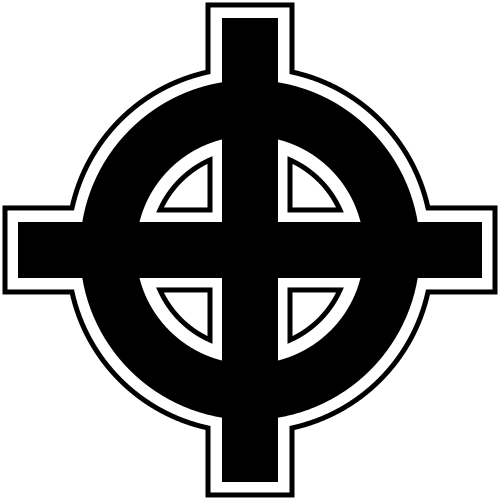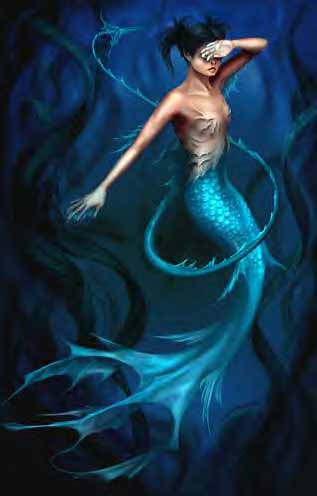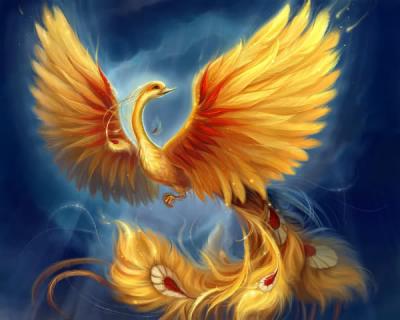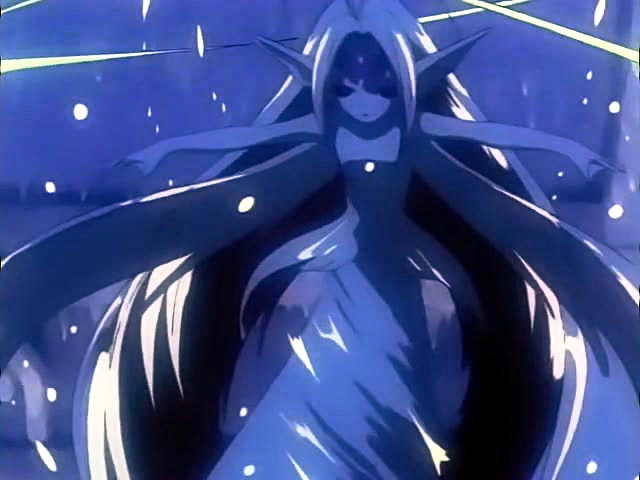When I began with the Firefish tutorial (which ultimately turned into a 'Moonfish') I learned the very basic tools and concepts. Below is a re-post of the finished tutorial picture that I made.
The picture was made almost entirely by creating and manipulating work paths. During this tutorial I didn't yet realise how to save work paths, so I ended up having to re-make a lot of paths that were altered or lost in various ways. I did, however, successfully work with layers as just about every section of the fish was a on a different layer. I found it such a natural concept so I picked up on it immediately. I also used the gradient tool a lot to fill paths and learned the use of layer masks. An example of where a layer mask was used is on the background moon (the original image is a full moon). I created a plain black background layer which I put at the bottom of all other layers, so when I added a layer mask to the moon the 'Moon Shadow' effect was made. On hindsight, having now knowledge of even more tools, I realise that I could have improved the fish with the use of the blur and smudge tools.
Another aspect I learned about is the importance of canvas size. Originally, I had made the canvas so big (by accident, I still don't know how I managed) that by the time the body of the fish was done (before the smoky wisps and the moon) the file was over 6GB in size. At this point it took about 20 minutes to save the file and at one time it even blue-screened the computer. This was one of the first lessons I took forward to the task of logo creation, ensuring that the canvas was a very modest size in comparison.
With the artwork that followed, I further practiced and improved my skills with Photoshop. Here are some of the images I made.
With the plane image, I used the select tool to select most of the background, and then refined the selection to make sure that the plane was not affected to get rid of the background. I used the plane to create a custom brush. Then I added a drop shadow onto the plane itself, and used the brush to make the coloured shadows. I originally intended to use this in the presentation about graphics concepts, but then decided against it since it obscured other images.
 With the collage, I had three images to work with: 'pen and mouse', 'pro cameras' and 'scanner and photocopier' images. From the last two, I only removed the background to make sure it was transparent (like with the plane). But with the pen and mouse, I had originally tried to find (and failed) an image of a graphics tablet pen instead. So I decided to use Photoshop to try and disguise the ballpoint pen to look more digital. This is where I learned to use the blur, sharpen and particularly the smudge tool. With the smudge tool, alternating between 'Normal', 'Darken' and 'Lighten' settings, I got rid of the ink cartridge inside and fused the button to just look like a solid end.
With the collage, I had three images to work with: 'pen and mouse', 'pro cameras' and 'scanner and photocopier' images. From the last two, I only removed the background to make sure it was transparent (like with the plane). But with the pen and mouse, I had originally tried to find (and failed) an image of a graphics tablet pen instead. So I decided to use Photoshop to try and disguise the ballpoint pen to look more digital. This is where I learned to use the blur, sharpen and particularly the smudge tool. With the smudge tool, alternating between 'Normal', 'Darken' and 'Lighten' settings, I got rid of the ink cartridge inside and fused the button to just look like a solid end.
With my logo designs and character designs I mostly used work paths (which I quickly learned to save and re-use). These were filled with either solid or gradient colours, then layer effects such as drop-shadows or glows added. I tested a lot of different effects, especially with the logos, which I found I could manipulate to create various effects. I found many that worked well together and some which don't. I stumbled on some really cool effects by accident, including the version of the Fenix logo where the bird was in the foreground and the feather was behind it blurred out in the background (looking like a watermark).
While I felt the logos were fit for purpose in that they explored several different possibilities and ideas and then worked with them, I realised along the way that I personally did not enjoy working with minimalist graphics. With many of the logos I commented that while I thought they looked good and enjoyed the way the design had turned out, I did not believe that it would work in practice very well as a logo. This being because many of them have a sort of level of detail that will be quickly lost if the image has to be printed very small (such as part of a letterhead or business card). However, when I managed to get a logo to be simple enough to work in practice as a logo, I did not personally like it very much (as was the case with the first and simpler 'Moon Games' logo which was just the drawn ellipse). It was too simple for my taste and so I didn't personally like it much.
As far as skills and understanding of Photoshop go, I feel that I have come a long way during this Unit. I feel that I have found a new, powerful and infinitely useful tool with which to work in the future. I had tried approaching Photoshop (and its derivatives) in the past. But since I'd gotten used to MS Paint style applications, I found that I didn't have the correct mentality to fully understand the ways in which Photoshop works and approaches images. But overcoming the first learning curve in this unit, I feel like I can now go on successfully to find and practice the more complete array of advanced tools that Photoshop has.
I also got an enormous amount of satisfaction out of the last task (creating the mage character) as I found that a task which used to take me hours and hours by hand (colouring in line art) was not only faster with Photoshop, but it allowed me the safety of non-destructive editing, a luxury I have not been able to afford when drawing by hand.
I don't feel that my skills are close enough to be considered 'professional', but I do feel that I'm at a level of ability now which exceeds what I was able to do before and has brought me closer to the ability to create beautiful and professional images. And it has given me a good starting point from which to move forward.

















































.full.428935.jpg)